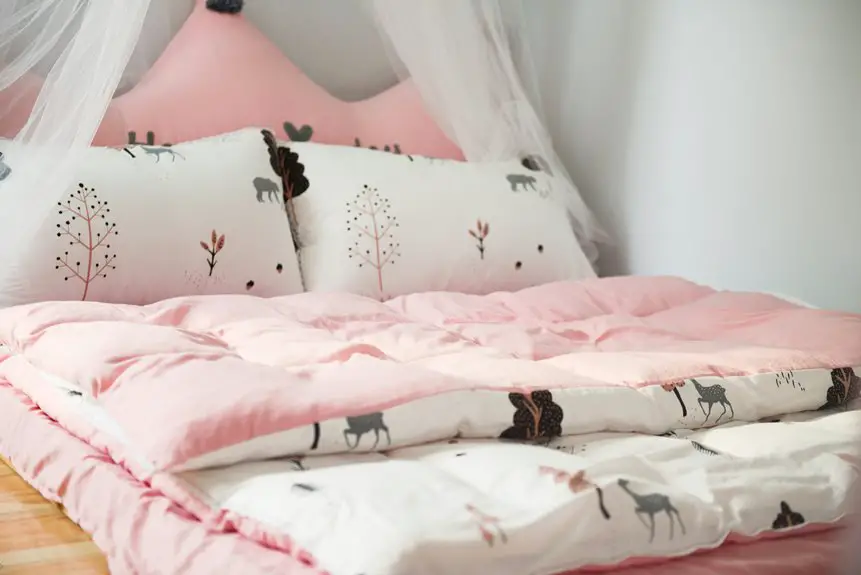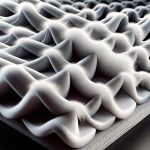When choosing sheets, you want something that keeps you cool and comfortable all night. Cotton, a natural fiber, often wins praise for breathability, while microfiber, a synthetic option, promises durability and softness. But which one actually helps your skin breathe and manages moisture better? Understanding these differences can make a big impact on how well you sleep, especially if temperature and moisture control matter to you.
Table of Contents
Key Takeaways
- Cotton sheets are more breathable than microfiber due to natural fibers allowing better air circulation.
- Microfiber sheets tend to trap heat and are less breathable because of their synthetic fibers.
- Breathability in cotton is enhanced by its weave pattern, fiber type, and fabric weight.
- Microfiber’s moisture retention may cause a clammy feeling, reducing overall breathability comfort.
- Cotton’s superior moisture-wicking ability helps keep bedding dry and comfortable throughout the night.
Understanding Breathability in Bedding Materials
When you choose sheets, breathability plays an essential role in your comfort throughout the night.
Breathability factors include how well a fabric allows air to circulate and moisture to escape, preventing overheating and sweat buildup. To understand these factors, you need to look at fabric comparisons carefully. Some materials have a tighter weave, which traps heat, while others are more open, encouraging airflow.
You’ll find that the weave pattern, fabric weight, and fiber type all influence breathability. By comparing these elements, you can pick sheets that keep you cool and dry.
Focusing on these breathability factors helps you make an informed decision about which bedding material suits your sleeping needs best.
Natural vs. Synthetic Fibers: Cotton and Microfiber
Although both cotton and microfiber are popular choices for sheets, they differ greatly because cotton is a natural fiber while microfiber is synthetic. Understanding these fiber properties helps you make an informed decision.
Cotton and microfiber sheets differ significantly due to their natural versus synthetic fiber origins.
Cotton’s natural origins give it breathability and softness, but it can wear down faster over time. Microfiber, made from finely woven synthetic fibers, offers enhanced material durability and resists wrinkles and stains better than cotton.
Consider these key differences:
- Cotton’s natural fiber promotes airflow and comfort.
- Microfiber’s synthetic fiber excels in strength and longevity.
- Cotton may require more care to maintain quality.
- Microfiber resists fading and shrinking after multiple washes.
Knowing these contrasts allows you to choose sheets that match your comfort and durability preferences.
How Moisture Control Affects Sleep Comfort
Since moisture control plays an essential role in your comfort throughout the night, choosing sheets that manage sweat and humidity effectively can improve your sleep quality.
Sheets with high moisture absorption, like cotton, help wick away sweat, keeping you dry and comfortable. When moisture lingers on your skin, it can cause discomfort and disrupt your sleep, making it harder to stay asleep or fall back asleep.
On the other hand, microfiber tends to hold moisture closer to the surface, which might leave you feeling clammy. By selecting sheets that regulate moisture well, you reduce night sweats and improve overall sleep quality.
Paying attention to moisture control guarantees you wake up refreshed, avoiding the irritation and restlessness caused by damp bedding.
Temperature Regulation and Heat Retention Differences
Understanding how your sheets handle temperature can make a big difference in your sleep comfort. When you pick between microfiber and cotton, consider their heat retention and temperature regulation properties carefully.
Microfiber tends to trap heat more, which might leave you feeling warmer through the night. Cotton, on the other hand, naturally promotes better airflow and helps regulate your body temperature.
Here’s what you should know:
- Microfiber offers higher heat retention, ideal for cooler nights.
- Cotton excels at temperature regulation, keeping you cooler.
- Microfiber’s synthetic fibers can feel less breathable.
- Cotton’s natural fibers wick moisture and allow air circulation.
Choosing the Right Sheet for Your Climate and Skin Sensitivity
When selecting sheets, you’ll want to contemplate both your local climate and how sensitive your skin is to different fabrics. Climate considerations influence whether you choose breathable cotton or soft microfiber. If you have skin allergies, hypoallergenic materials are essential to avoid irritation. Use this guide to match your needs:
| Climate | Best Sheet Type | Skin Sensitivity Recommendation |
|---|---|---|
| Hot and Humid | Cotton | Lightweight, natural fibers |
| Cold and Dry | Microfiber | Soft, insulating fabric |
| Moderate Climate | Either | Based on personal comfort |
| Sensitive Skin | Organic Cotton | Chemical-free, breathable |
| Allergy Prone | Microfiber | Hypoallergenic, easy to wash |
Frequently Asked Questions
How Do Microfiber and Cotton Sheets Compare in Durability Over Time?
You’ll find the durability comparison shows microfiber resists wear better, but cotton offers a natural feel with decent longevity. Your longevity analysis depends on care: microfiber lasts longer, while cotton softens yet may wear faster over time.
Which Material Is Easier to Care for and Maintain?
You’ll find microfiber easier to care for since its care instructions allow frequent wash cycles without damage. Cotton needs gentler handling and fewer wash cycles to maintain quality, so it requires more attention in maintenance.
Are There Environmental Impacts Associated With Microfiber Production?
You should know microfiber production contributes to microfiber pollution, harming oceans. Cotton sustainability varies; organic cotton’s better but still water-intensive. Choosing wisely helps reduce environmental impact, so consider both when picking your sheets or fabrics.
How Do Cotton and Microfiber Sheets Differ in Softness and Feel?
Imagine touching a cloud versus silk; cotton’s natural sheet texture feels soft and breathable, with moderate fabric weight, while microfiber’s lighter, smoother feel wraps you like a gentle breeze, offering silky softness but less airiness.
Can Microfiber Sheets Cause Allergic Reactions or Skin Irritation?
You might experience allergy symptoms or skin sensitivity with microfiber sheets if you’re prone to allergies. They can trap dust and irritants, so always check for reactions and choose hypoallergenic options to avoid discomfort.
- Current Satin Fabric Price in Bangladesh for Garments and Decor - June 21, 2025
- A Guide to Interlock Fabric Manufacturers in Bangladesh - June 21, 2025
- What Caused the Rana Plaza Factory Collapse? An In-Depth Look - June 21, 2025





